Water Retention Capacity of Leaf Litter According to Field Lysimetry
Abstract
1. Introduction
2. Materials and Methods
2.1. Study Area
2.2. Data Collection
2.3. Estimation of Water Balance Parameters
2.4. Statistical Analysis
3. Results
3.1. Water Retention Capacity of Leaf Litter
3.2. Litter Moisture Depletion Curve
3.3. Water Balance Analysis for Rainfall Periods
4. Discussion
5. Conclusions
Author Contributions
Funding
Data Availability Statement
Acknowledgments
Conflicts of Interest
References
- Korea Forest Service. Statistical Yearbook of Forestry 2021; Korea Forest Service: Daejeon, Republic of Korea, 2021; pp. 40–41. [Google Scholar]
- Dunkerley, D. Percolation through leaf litter: What happens during rainfall events of varying intensity? J. Hydrol. 2015, 525, 737–746. [Google Scholar] [CrossRef]
- Gomyo, M.; Kuraji, K. Effect of the litter layer on runoff and evapotranspiration using the paired watershed method. J. For. Res. 2016, 21, 306–313. [Google Scholar] [CrossRef]
- Gavazzi, M.J.; Sun, G.; McNulty, S.G.; Treasure, E.A.; Wightman, M.G. Canopy rainfall interception measured over ten years in a coastal plain loblolly pine (Pinus taeda L.) plantation. Trans. ASABE 2016, 59, 601–610. [Google Scholar]
- Guevara-Escobar, A.; González-Sosa, E.; Véliz-Chávez, C.; Ventura-Ramos, E.; Ramos-Salinas, M. Rainfall interception and distribution patterns of gross precipitation around an isolated Ficus benjamina tree in an urban area. J. Hydrol. 2007, 333, 532–541. [Google Scholar] [CrossRef]
- Bernard, J.M. Forest floor moisture capacity of the New Jersey pine barrens. J. Ecol. 1963, 44, 574–576. [Google Scholar] [CrossRef]
- Reynolds, J.F.; Knight, D.H. The magnitude of snowmelt and rainfall interception by litter in lodgepole pine and spruce-fir forests in Wyoming. Northwest Sci. 1973, 47, 50–60. [Google Scholar]
- Rosalem, L.M.; Wendland, E.C.; Anache, J.A. Understanding the water dynamics on a tropical forest litter using a new device for interception measurement. Ecohydrology 2019, 12, e2058. [Google Scholar] [CrossRef]
- Sato, Y.; Kumagai, T.O.; Kume, A.; Otsuki, K.; Ogawa, S. Experimental analysis of moisture dynamics of litter layers—The effects of rainfall conditions and leaf shapes. Hydrol. Process. 2004, 18, 3007–3018. [Google Scholar] [CrossRef]
- Li, Q.; Lee, Y.E.; Im, S. Characterizing the interception capacity of floor litter with rainfall simulation experiments. Water 2020, 12, 3145. [Google Scholar] [CrossRef]
- Helvey, J.; Patric, J. Canopy and litter interception of rainfall by hardwoods of eastern United States. Water Resour. Res. 1965, 1, 193–206. [Google Scholar] [CrossRef]
- Gerrits, A.M.J.; Savenije, H.H.G. Forest floor interception. In Forest Hydrology and Biogeochemistry; Ecological Studies 216; Levia, D.F., Carlyle-Moses, D., Tanaka, T., Eds.; Springer: New York, NY, USA, 2011; p. 423.407. [Google Scholar]
- Putuhena, W.M.; Cordery, I. Estimation of interception capacity of the forest floor. J. Hydrol. 1996, 180, 283–299. [Google Scholar] [CrossRef]
- Li, X.; Niu, J.; Xie, B. Study on hydrological functions of litter layers in North China. PLoS ONE 2013, 8, e70328. [Google Scholar] [CrossRef]
- Schaap, M.; Bouten, W. Forest floor evaporation in a dense Douglas fir stand. J. Hydrol. 1997, 193, 97–113. [Google Scholar] [CrossRef]
- Gerrits, A.; Savenije, H.; Hoffmann, L.; Pfister, L. New technique to measure forest floor interception–an application in a beech forest in Luxembourg. Hydrol. Earth Syst. Sci. 2007, 11, 695–701. [Google Scholar] [CrossRef]
- Beeson, R.C. Weighing lysimeter systems for quantifying water use and studies of controlled water stress for crops grown in low bulk density substrates. Agric. Water Manag. 2011, 98, 967–976. [Google Scholar] [CrossRef]
- Korea Meteorological Administration. Available online: https://data.kma.go.kr (accessed on 13 December 2022).
- Im, S.; Lee, W.S.; Kim, H.; Seoul National University Forests. Developing a Network of Long-Term Research Field Stations to Monitor Environmental Changes and Ecosystem Responses in Asian Forests, 1st ed.; Kamata, N., Kuraji, K., Owari, T., Guan, B.T., Eds.; The University of Tokyo Forests Press: Tokyo, Japan, 2019; Volume 1, pp. 39–50. [Google Scholar]
- Katabuchi, M. LeafArea: An R package for rapid digital image analysis of leafarea. Ecol. Res. 2015, 30, 1073–1077. [Google Scholar] [CrossRef]
- Kang, M.; Kim, J.; Lee, S.-H.; Kim, J.; Chun, J.-H.; Cho, S. Changes and improvements of the standardized eddy covariance data processing in KoFlux. Korean J. Agric. For. Meteorol. 2018, 20, 5–17. [Google Scholar]
- Yang, H.; Choi, H.T.; Lim, H. Applicability assessment of estimation methods for baseflow recession constants in small forest catchments. Water 2018, 10, 1074. [Google Scholar] [CrossRef]
- Semago, W.T.; Nash, A.J. Interception of precipitation by a hardwood forest floor in the Missouri Ozarks. Univ. Mo. Agr. Exp. Stan. Res. Bull. 1962, 796, 1–31. [Google Scholar]
- Gash, J.H.; Lloyd, C.; Lachaud, G. Estimating sparse forest rainfall interception with an analytical model. J. Hydrol. 1995, 170, 79–86. [Google Scholar] [CrossRef]
- R Core Team. R: A Language and Environment for Statistical Computing; R Foundation for Statistical Computing: Vienna, Austria, 2022; Available online: https://www.R-project.org/ (accessed on 11 November 2022).
- Gerke, K.; Sidle, R.; Mallants, D.; Valisyev, R.; Karsanine, M.; Skvortsova, E.; Korost, D. Biomat Flow: From Field Experiments with Dyes to Pore-scale Modelling of Transport Properties and Flow Models. In Proceedings of the AGU Fall Meeting, San Francisco, CA, USA, 9–13 December 2013; p. 274313. [Google Scholar]
- Aston, A.R. Rainfall interception by eight small trees. J. Hydrol. 1979, 42, 383–396. [Google Scholar] [CrossRef]
- Sato, Y.; Otsuki, K.; Ogawa, S. Estimation of the Litter interception Loss in the Evergreen Forest. J. Jpn. Soc. Hydrol. Water Resour. 2003, 16, 640–651. [Google Scholar] [CrossRef]
- Pathak, P.C.; Pandey, A.N.; Singh, J.S. Apportion of rainfall in central Himalayan forests (India). J. Hydrol. 1985, 76, 319–332. [Google Scholar] [CrossRef]
- Bulcock, H.H.; Jewitt, G.P.W. Field data collection and analysis of canopy and litter interception in commercial forest plantation in the KwaZulu-Natal Midlands, South Africa. Hydrol. Earth Syst. Sci. 2012, 16, 3717–3728. [Google Scholar] [CrossRef]
- Pereira, F.; Gash, J.; David, J.; Valente, F. Evaporation of intercepted rainfall from isolated evergreen oak trees: Do the crowns behave as wet bulbs? Agric. For. Meteorol. 2009, 149, 667–679. [Google Scholar] [CrossRef]
- Gosz, J.R.; Likens, G.E.; Bormann, F.H. Nutrient release from decomposing leaf and branch litter in the Hubbard Brook Forest, New Hampshire. Ecol. Monogr. 1973, 43, 173–191. [Google Scholar] [CrossRef]
- Cha, J.Y.; Im, S.; Lee, S.Y.; Ohga, S. Diversity of Fungal Species Isolated from Litter-mycelial Mats in the Litter Layer of a Korean Deciduous Forest. J. Fac. Agric. Kyushu Univ. 2011, 56, 237–241. [Google Scholar] [CrossRef]
- Matthews, S. The water vapour conductance of Eucalyptus litter layers. Agric. For. Meteorol. 2005, 135, 73–81. [Google Scholar] [CrossRef]

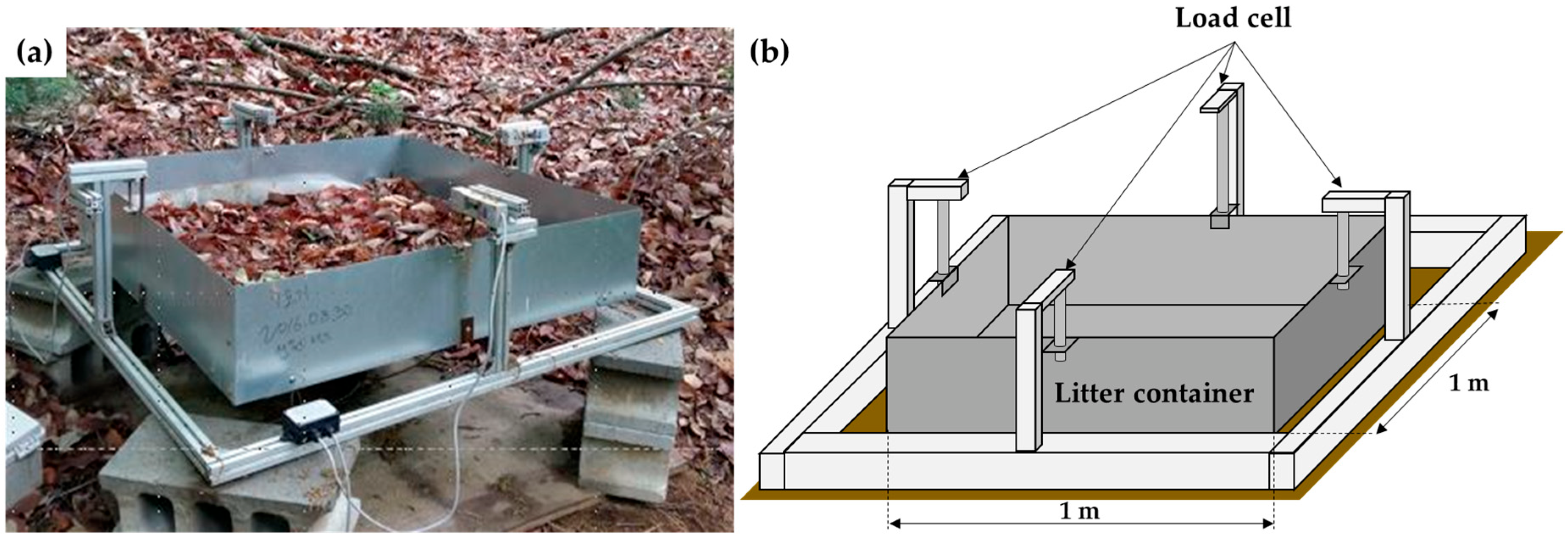
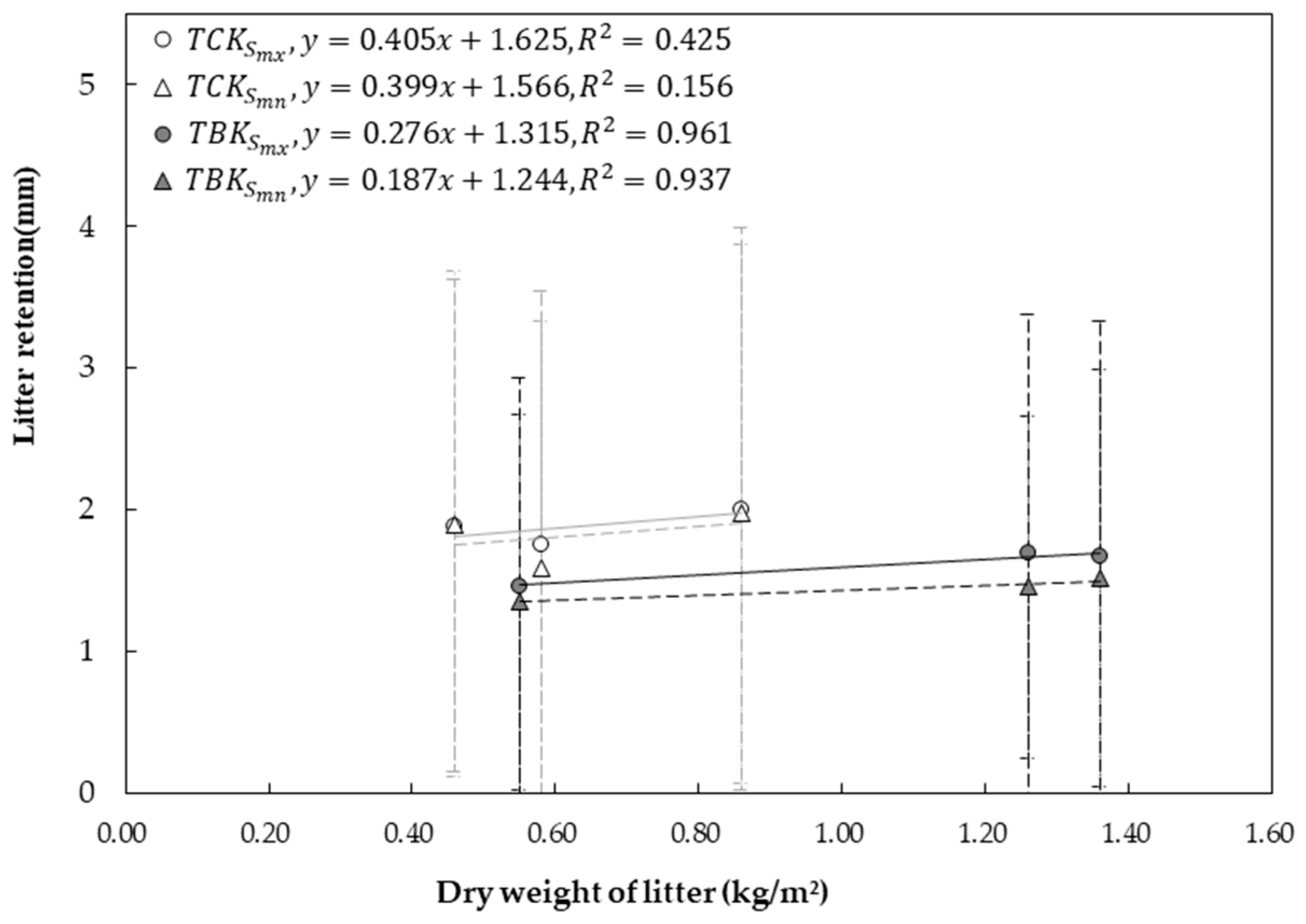
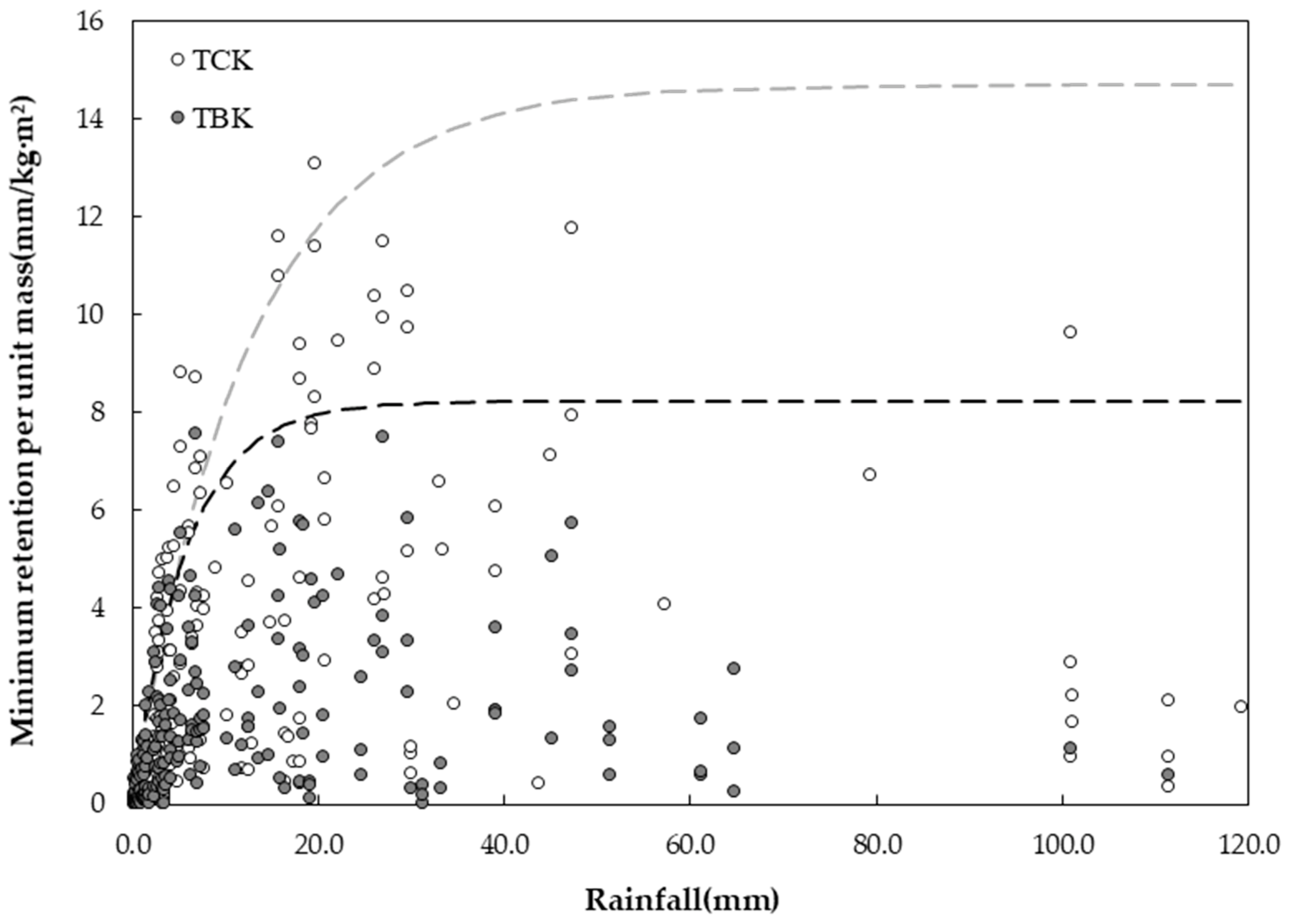
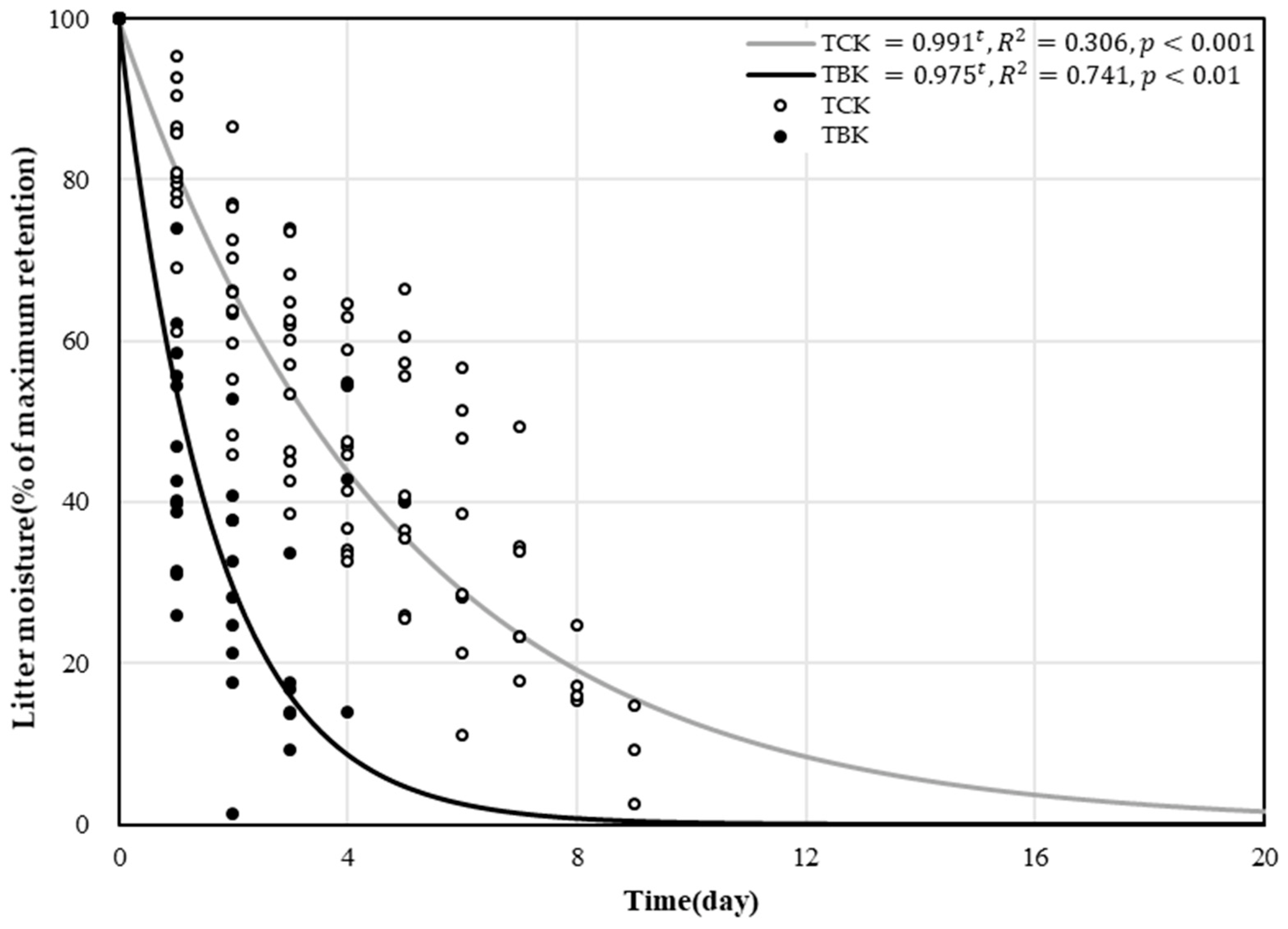
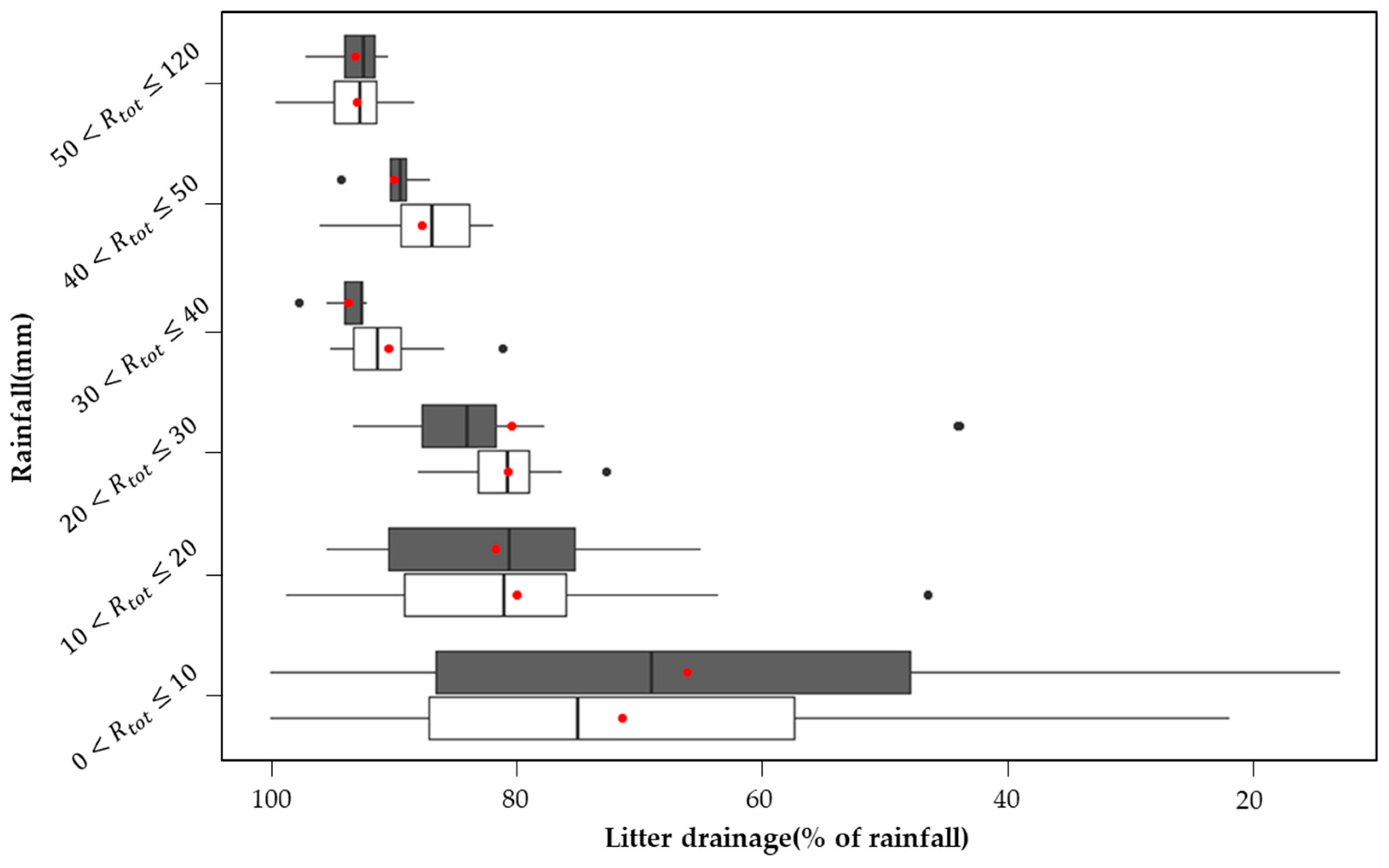
| Forest | Tree Sample (n = 12) | Leaf Sample | |||||
|---|---|---|---|---|---|---|---|
| Tree Species | DBH (cm) | Height (m) | n | Length (mm) | Width (mm) | Dry Weight (kg/m2) | |
| Deciduous | Q. acutissima | 24.1 ± 8.5 | 13.6 ± 3.3 | 67 | 155.1 ± 22.0 | 41.2 ± 7.5 | 0.09 ± 0.02 |
| Coniferous | P. koraiensis | 33.2 ± 1.5 | 18.4 ± 1.5 | 600 | 84.9 ± 16.1 | 0.8 ± 0.1 | 0.18 ± 0.02 |
| Lysimeter | Litter Load (kg/m2) 1 | Rainfall Data | ||||
|---|---|---|---|---|---|---|
| Air-Dried | Oven-Dried | No. Event | Amount (mm) | Duration (h) | Intensity 2 (mm/h) | |
| TBK1 | 1.42 | 1.26 | 99 | 9.19 ± 13.99 | 5.14 ± 5.46 | 3.54 ± 4.77 |
| TBK2 | 0.62 | 0.55 | 70 | 9.68 ± 14.59 | 5.55 ± 5.64 | 3.55 ± 4.96 |
| TBK3 | 1.52 | 1.36 | 85 | 11.76 ± 19.90 | 5.91 ± 6.07 | 4.17 ± 5.77 |
| TCK1 | 0.94 | 0.58 | 91 | 13.06 ± 22.36 | 6.88 ± 7.72 | 3.70 ± 5.79 |
| TCK2 | 0.75 | 0.46 | 80 | 11.57 ± 22.13 | 5.36 ± 5.58 | 4.22 ± 6.58 |
| TCK3 | 1.40 | 0.86 | 87 | 12.55 ± 24.65 | 5.32 ± 6.02 | 4.49 ± 7.03 |
| Lysimeter | Maximum Retention Storage (mm) | Minimum Retention Storage (mm) |
|---|---|---|
| TBK1 | 1.69 ± 1.28 | 1.46 ± 1.21 |
| TBK2 | 1.46 ± 1.33 | 1.35 ± 1.32 |
| TBK3 | 1.67 ± 1.57 | 1.56 ± 1.47 |
| TCK1 | 1.75 ± 1.79 | 1.58 ± 1.75 |
| TCK2 | 1.90 ± 1.79 | 1.89 ± 1.74 |
| TCK3 | 2.01 ± 1.99 | 1.97 ± 1.90 |
| Lysimeter | Rainfall | Water | Evaporation | Litter |
|---|---|---|---|---|
| Amount (mm) 1 | Retention (mm) | Loss (mm) | Drainage (mm) | |
| TBK1 | 836.0 | 103.3 (12.4%) 2 | 51.9 (6.2%) | 680.8 (81.4%) |
| TBK2 | 774.6 | 84.9 (11.0%) | 33.5 (4.3%) | 656.2 (84.7%) |
| TBK3 | 1023.3 | 103.2 (10.1%) | 52.3 (5.1%) | 867.8 (84.8%) |
| TCK1 | 1292.5 | 166.3 (12.9%) | 25.5 (2.0%) | 1100.7 (85.2%) |
| TCK2 | 809.8 | 120.8 (14.9%) | 12.2 (1.5%) | 676.8 (83.6%) |
| TCK2 | 1066.8 | 152.4 (14.3%) | 14.4 (1.3%) | 900.0 (84.4%) |
Disclaimer/Publisher’s Note: The statements, opinions and data contained in all publications are solely those of the individual author(s) and contributor(s) and not of MDPI and/or the editor(s). MDPI and/or the editor(s) disclaim responsibility for any injury to people or property resulting from any ideas, methods, instructions or products referred to in the content. |
© 2023 by the authors. Licensee MDPI, Basel, Switzerland. This article is an open access article distributed under the terms and conditions of the Creative Commons Attribution (CC BY) license (https://creativecommons.org/licenses/by/4.0/).
Share and Cite
Kim, T.; Kim, J.; Lee, J.; Kim, H.S.; Park, J.; Im, S. Water Retention Capacity of Leaf Litter According to Field Lysimetry. Forests 2023, 14, 478. https://doi.org/10.3390/f14030478
Kim T, Kim J, Lee J, Kim HS, Park J, Im S. Water Retention Capacity of Leaf Litter According to Field Lysimetry. Forests. 2023; 14(3):478. https://doi.org/10.3390/f14030478
Chicago/Turabian StyleKim, Taehyun, Jungyoon Kim, Jeman Lee, Hyun Seok Kim, Juhan Park, and Sangjun Im. 2023. "Water Retention Capacity of Leaf Litter According to Field Lysimetry" Forests 14, no. 3: 478. https://doi.org/10.3390/f14030478
APA StyleKim, T., Kim, J., Lee, J., Kim, H. S., Park, J., & Im, S. (2023). Water Retention Capacity of Leaf Litter According to Field Lysimetry. Forests, 14(3), 478. https://doi.org/10.3390/f14030478









